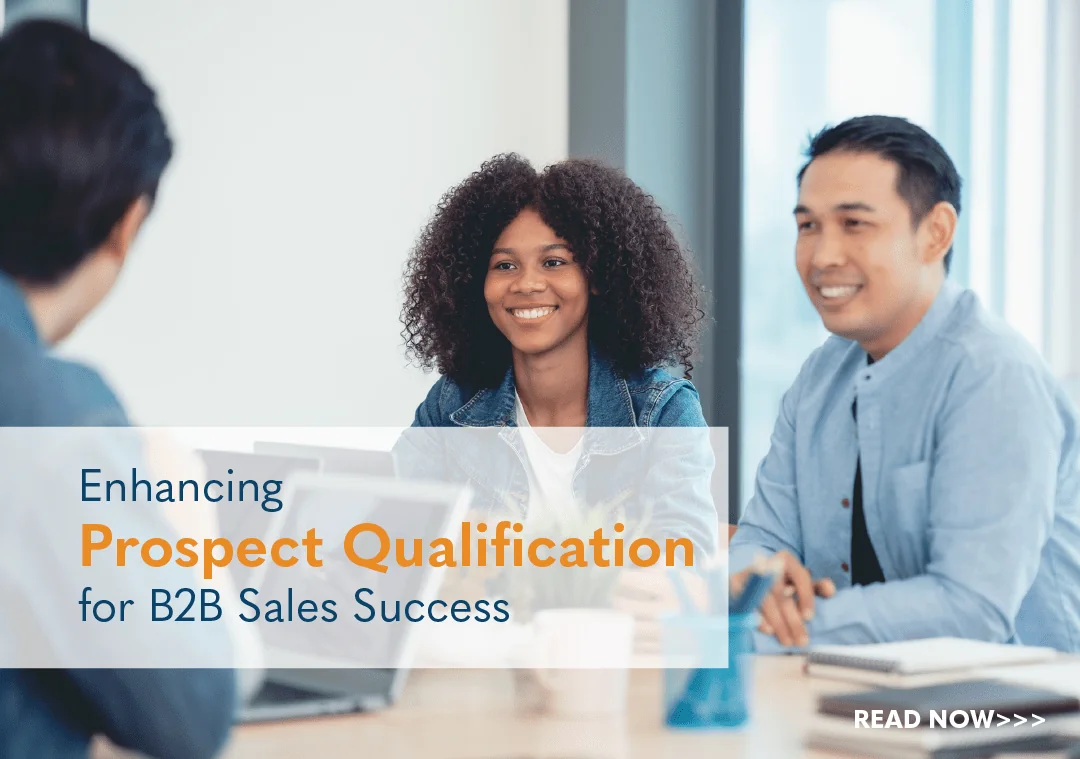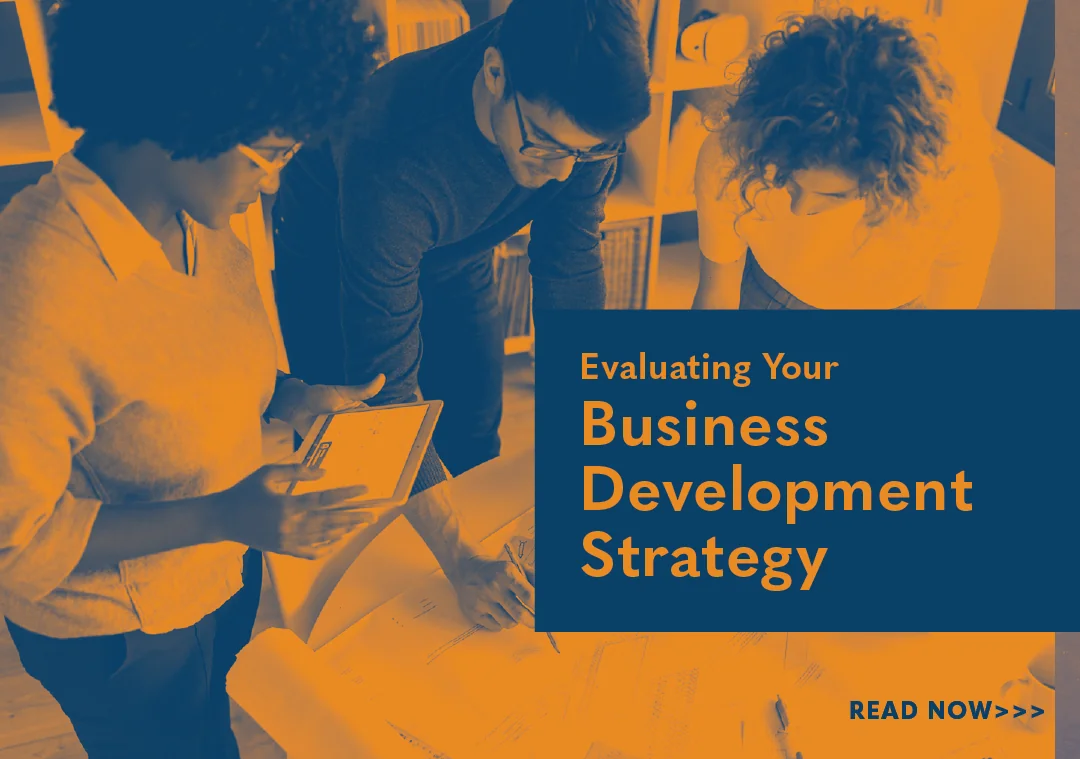Enhancing Prospect Qualification for B2B Sales Success

In the competitive landscape of B2B sales, effectively qualifying prospects is paramount. It involves assessing the fit and readiness of potential leads based on various criteria. These include their needs, budget, timeline, and decision-making authority, among others. This makes qualification essential to drive revenue growth, optimize resource allocation, and foster long-term customer relationships.
However, many B2B sales teams struggle with inefficient qualification processes. In fact, two statistics cited in Spotio are eye opening:
- 46% of B2B sales reps list lead quantity and quality as their top challenge.
- 67% of lost sales result from improper qualification.
From this, it’s easy to see the importance of qualification. That’s why it’s a central element of our recent webinar, Turbocharging Business Development Strategies. There, we looked at key indicators to assess before passing prospects to sales. Now, we’ll go further and explore strategies and best practices for improving prospect qualification.
Understanding Prospect Qualification
Prospect qualification is the process of evaluating potential leads. The purpose is to determine their suitability and readiness to engage with your company’s products or services.
Effective qualification enables sales teams to prioritize their efforts. This includes focusing on prospects with the highest likelihood of conversion and allocating resources efficiently. Key aspects of prospect qualification include:
- Fit criteria
- Budget
- Authority
- Timeline
- Pain points
Start with assessing the prospect’s needs, challenges, and objectives. Then, determine if these align with your company’s offerings. Further, do they match your value proposition? The goal is to discover if your solutions can help solve the prospect’s problem. And, if so, is the prospect worth your time and effort?
Next, determine if the prospect has the financial resources to invest in your solution. There is no sense investing in prospects who unable or unwilling to commit within a reasonable timeframe.
Identifying decision makers and influencers within the prospect’s organization is key. These are the people with the power to greenlight purchasing decisions. Ideally, sellers should learn the economic buyers early in the process. This ensures they are dealing with the proper authority. Without this, your team’s best efforts can be a waste.
The prospect’s buying timeline and urgency are also essential. Has the prospect indicated they are prepared to decide within a reasonable timeframe? This should include any specific deadlines or milestones driving their purchasing decision. Have they agreed to follow-up meetings with sellers? This information can determine if a prospect is worth the effort.
In addition, sellers should look for intent signals. These are things happening within the account that could indicate readiness to buy. For example, new leadership, financing, or a product launch. Also, note things like an office expansion or changes in their competitive landscape.
Finally, uncover the prospect’s pain points, priorities, and motivations for seeking a solution. Through this, your team can get an early start demonstrating how your offering addresses their needs.
Challenges in Prospect Qualification
Despite its importance, prospect qualification poses several challenges for B2B sales teams, including:
- Lack of clarity
- Ineffective communication
- Time constraints
- Complex buying processes
- Limited data and insights
Unclear or inconsistent qualification criteria can lead to subjective decision-making and confusion among sales professionals.
Miscommunication or misalignment between sales and marketing teams can delay or derail the process. This can result in leads that are prematurely passed to sales without proper qualification. In fact, Gartner research shows the importance of aligning sales and marketing. They note, 42% of businesses noticed faster connections with qualified leads.
Sales reps often face time constraints and pressure to meet quotas. This can be especially true of young, inexperienced BDRs who may prioritize quantity over quality. It can result in rushed qualification processes and missed opportunities.
In addition, B2B sales cycles can be complex. They can involve multiple stakeholders, lengthy decision-making processes, and complex procurement requirements. These have the potential of making qualification more challenging.
In fact, according to Sales Mastery, selling was clearly more challenging in 2023 than in 2022. This is illustrated in conversion rates through the stages of the sales process. For example, from reported lead to first discussion, rates dropped from 31 to 23%. From first discussions to presentations, it fell from 41 to 31%. And from first discussions to proposals, it dropped from 45 to 40%.
Inadequate access to prospect data and market insights can hinder accurate qualification and personalized engagement. Ensure all team members, such as SDRs, BDRs, and account managers, have equal access throughout the sales process.
Strategies for Improving Prospect Qualification
To address these challenges and enhance prospect qualification, consider implementing the following strategies:
- Define clear qualification criteria
- Implement lead scoring
- Utilize qualification workflows and playbooks
- Enhance data collection and enrichment
- Encourage hyperpersonalization
- Emphasize collaboration and alignment
- Provide ongoing training, coaching, and development
- Stress continuous improvement
- Strive for stronger relationships
In collaboration with sales, marketing, and product teams, establish clear and objective qualification criteria. These must align with your company’s ideal customer profile (ICP) and buyer personas. Identify key indicators of fit. These include industry vertical, company size, pain points, and growth stage. In addition, focus on high-value targets. According to Gartner, this helped 41% of businesses increase win rates and close bigger deals.
Plus, Gartner notes 75% of B2B buyers prefer to transact without direct sales interaction. Instead, they often rely on self-guided research through websites and other digital assets. This requires more from marketing in terms of attracting, nurturing, and qualifying leads.
Develop a lead scoring framework to assign numerical values to leads based on their fit. This score fluctuates based on activity. This includes actions taken by prospects, such as engaging with content, opening emails, and frequency of website visits. According to Aberdeen research, effective lead scoring results in a 192% higher qualification rate.
In addition, use automation tools and CRM systems to track prospect interactions. These include website visits, email opens, and content downloads. Once these are ascertained, adjust lead scores accordingly. The prospect’s level of intent helps determine the amount of outreach needed. Therefore, this should be reviewed regularly.
Create standardized qualification workflows and playbooks. These systematically guide sales reps through the qualification process. They also ensure all reps use the same qualification criteria. Also, define clear qualification questions and scripts for different buyer personas and use cases. These ensure consistency and efficiency in qualification efforts.
Leverage data enrichment tools and third-party databases to gather comprehensive information about prospects. This includes firmographics, technographics, and social insights. Integrate data sources with your CRM system to provide sales reps with real-time access to prospect data and insights during qualification.
Personalization is another key. Today, this is more than just knowing a prospect’s name and communication style. Instead, hyperpersonalization means providing value and insight at each touchpoint through your ABM strategy. This can boost account engagement 28%. In addition, it can improve conversion rates from Marketing Qualified Leads to Sales Accepted Leads 25%.
Foster alignment between sales and marketing teams. This is achieved through regular communication, shared goals, and collaborative lead management processes. Also, implement Service Level Agreements (SLAs) to define the criteria for lead handoff from marketing to sales. Further, establish clear expectations for lead quality and follow-up.
Provide ongoing training and coaching to sales reps on effective qualification techniques. This should also include objection handling and active listening skills, key to building momentum and generating interest. Additionally, within the sales organization, encourage a culture of continuous learning and knowledge sharing. This helps all sales reps adapt to evolving market dynamics and customer needs.
To identify areas for improvement, regularly review and analyze qualification data, conversion rates, and sales outcomes. This should include soliciting feedback from sales reps, customers, and internal stakeholders. From this, you can refine qualification criteria, processes, and strategies over time.
Build relationships at each stage of the sales process. Interestingly, the Sales Mastery Scorecard shows a direct correlation between win rates and level of relationship. Of organizations perceived as “transactional venders,” 17% achieved a lead to first discussion greater than 50%. This rises to 22% for those viewed as “solution consultants,” organizations that provide support services and insights for their products.
However, there’s a more dramatic rise for organizations perceived as “strategic collaborators” or “trusted co-creators” of solutions. These organizations see their lead to first discussion conversion rate jump to 37%. This makes early rapport and relationship building key components of improved conversions.
Conclusion
As a top-funnel activity, qualification lays the groundwork for effective selling. It jumpstarts an organization’s ability to deliver value and grow revenue. Through this, sales teams stay ahead of the competition and adapt to evolving market dynamics. By prioritizing prospect qualification as a strategic priority, organizations unlock new opportunities for success.
We hope this helps your sales organization enhance your prospect qualification. For more, see our webinar Turbocharging Business Development Strategies.

- Account Planning (11)
- Awards (49)
- Client Testimonial (37)
- Personal Branding (19)
- Podcast (11)
- Research (70)
- Sales Career Development (87)
- Sales Coaching (156)
- Sales Consulting (137)
- Sales Culture (170)
- Sales Enablement (354)
- Sales Leadership (109)
- Sales Management (248)
- Sales Negotiation (16)
- Sales Prospecting (125)
- Sales Role-Playing (18)
- Sales Training (235)
- Selling Strategies (263)
- Soft Skills (70)
- Talent Management (94)
- Trusted Advisor (27)
- Virtual Selling (49)
- Webinar (9)


























